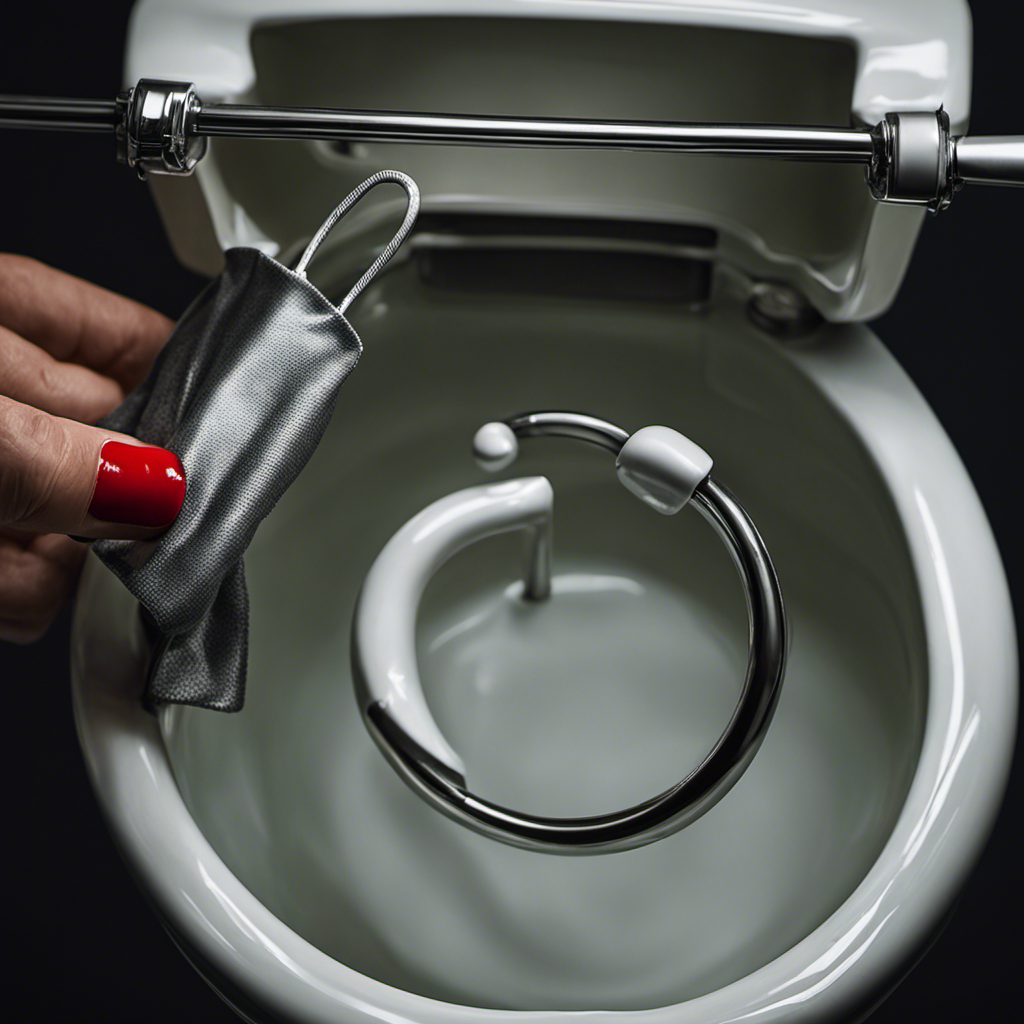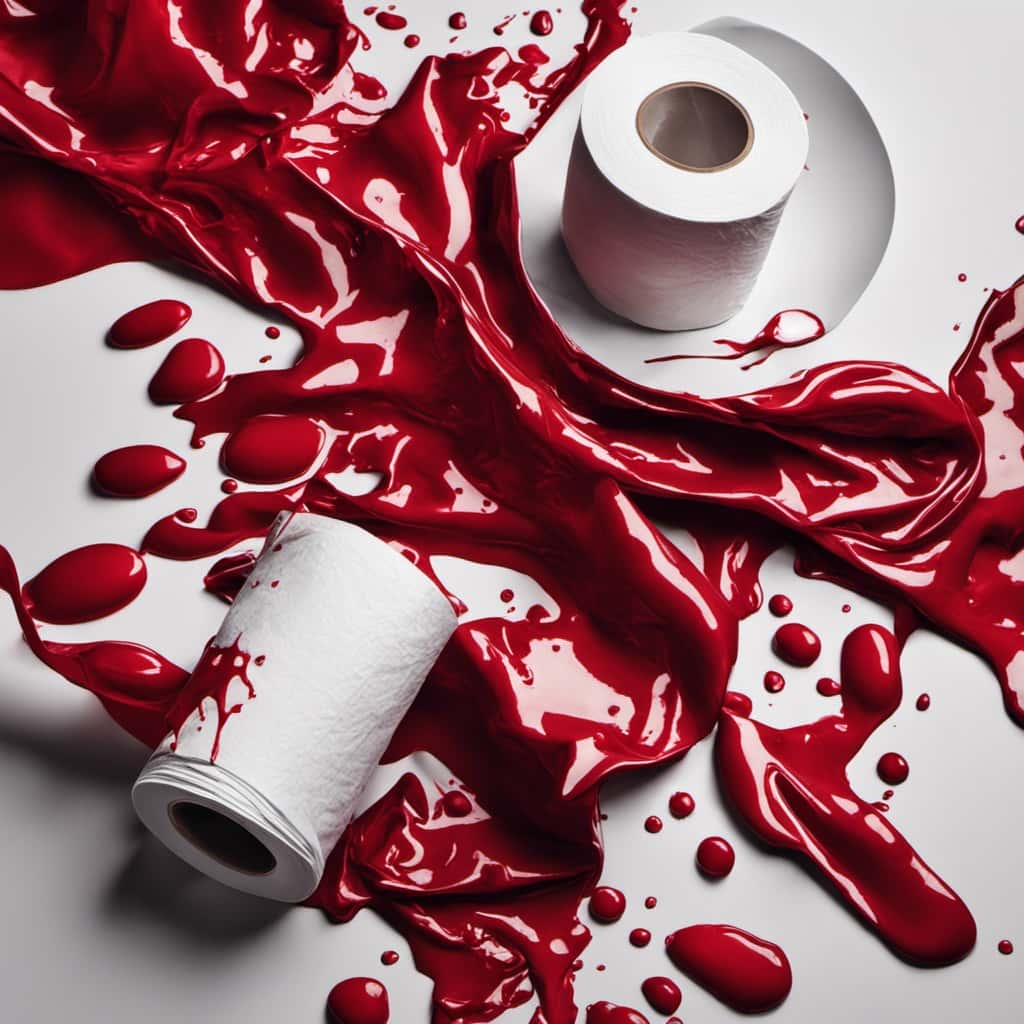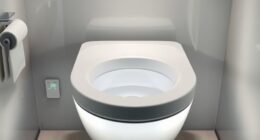Are you tired of looking at those unsightly rings in your toilet bowl? Don’t worry, we’ve got you covered. In this article, we will show you how to easily get rid of those stubborn toilet rings once and for all.
With our step-by-step guide and expert tips, you’ll be able to tackle this common bathroom issue with confidence. Say goodbye to those pesky rings and hello to a sparkling clean toilet in no time.
Let’s get started!
Key Takeaways
- Toilet rings are caused by a buildup of minerals and bacteria in the water.
- Choosing the right cleaning products, such as those specifically formulated for removing toilet rings, is important.
- Safe cleaning practices, including using mild detergents or vinegar solutions, help prevent and remove toilet rings.
- Natural remedies like vinegar, lemon juice, and baking soda can be effective in removing toilet rings, while regular maintenance helps prevent their buildup.
Understanding the Causes of Toilet Rings
To understand the causes of toilet rings, you need to know what materials are causing the stains. Toilet rings are often caused by a buildup of minerals and bacteria in the water.
Hard water, which contains high levels of minerals like calcium and magnesium, can leave behind deposits that form rings. These mineral deposits can also attract bacteria, which can further contribute to the discoloration.
Additionally, the quality of the water can have an impact on the formation of toilet rings. Water that is high in iron or other contaminants can lead to more severe staining.
It’s important to address the causes of discoloration in order to effectively remove and prevent toilet rings.
Choosing the Right Cleaning Products for Removing Toilet Rings
When it comes to removing toilet rings, it’s important to choose cleaning products that are both effective and safe for your toilet surfaces.
There are various options available that can effectively tackle those stubborn stains while also being gentle on your toilet.
Look for cleaning products that are specifically formulated for removing toilet rings and are labeled as safe for use on porcelain or other toilet surfaces.
Effective Cleaning Product Options
You can try using a bleach-based cleaner to effectively remove the rings in your toilet. Bleach is a powerful cleaning agent that can break down tough stains and eliminate bacteria.
But if you’re looking for more eco-friendly options, there are several effective cleaning techniques you can try. Consider using white vinegar, which is a natural disinfectant that can dissolve mineral deposits and eliminate odors. Another option is baking soda, which can be mixed with water to create a paste that can scrub away stains without harming the surface of your toilet. Additionally, hydrogen peroxide is a safe and effective cleaner that can remove toilet rings and kill germs. These eco-friendly options can provide a deep clean without the harsh chemicals.
Transitioning into the next section, it’s important to choose cleaning products that are safe for toilet surfaces.
Safe for Toilet Surfaces
Using gentle cleaning products is essential to protect the surfaces of your toilet. Harsh chemicals can cause damage and lead to the formation of stubborn toilet rings. These unsightly stains are usually caused by a buildup of minerals, bacteria, or mold.
To prevent toilet rings, it’s important to address the root causes. Hard water, for example, can leave mineral deposits that contribute to the formation of rings. Consider installing a water softener to reduce mineral content. Regular cleaning with a mild detergent or vinegar solution can also help remove any potential buildup.
Additionally, using a toilet brush with soft bristles and avoiding abrasive cleaners will help protect the delicate porcelain surface. By taking these preventative measures and using gentle cleaning products, you can keep your toilet looking clean and ring-free.
Step-By-Step Guide to Scrubbing Away Toilet Rings
To effectively scrub away toilet rings, start by applying a mixture of vinegar and baking soda to the affected areas. This powerful combination works wonders in breaking down stubborn stains and eliminating odors.
Here’s a step-by-step guide to help you remove those unsightly rings from your toilet:
- Mix equal parts of vinegar and baking soda in a bowl to create a paste.
- Apply the paste to the toilet rings, making sure to cover the entire affected area.
- Let the mixture sit for 15-30 minutes to allow it to penetrate the stains.
- Use a toilet brush or scrubber to vigorously scrub the rings, applying pressure to remove the stains.
By following these simple DIY steps, you can effectively remove toilet rings and restore your toilet’s pristine appearance.
Natural Remedies for Getting Rid of Toilet Rings
If you’re looking for natural remedies to get rid of those stubborn toilet rings, there are a couple of key ingredients you should consider: vinegar and lemon juice.
Vinegar, with its acidic properties, is an effective cleaning agent that can break down mineral deposits and stains. Simply pour some vinegar into the toilet bowl, let it sit for a while, and then scrub away the rings with a toilet brush.
On the other hand, lemon juice is known for its powerful cleaning abilities and pleasant scent. Squeeze some lemon juice onto the toilet rings, let it sit for a few minutes, and then scrub away the stains.
Vinegar as Cleaning Agent
Simply pour vinegar into the toilet bowl and let it sit for a few hours to effectively remove those stubborn rings. Vinegar is a powerful cleaning agent that can break down mineral deposits and grime, making it an excellent choice for tackling toilet stains.
But did you know that combining vinegar with baking soda can enhance its cleaning capabilities even further? Here are some benefits of using vinegar and baking soda together for cleaning your toilet:
- The chemical reaction between vinegar and baking soda creates a foaming action that helps to dislodge tough stains.
- Baking soda acts as a gentle abrasive, helping to scrub away dirt and grime without scratching the surface.
- Vinegar has natural antibacterial properties, making it effective at killing germs and eliminating odors.
- Using vinegar and baking soda is an eco-friendly alternative to harsh chemical cleaners, reducing your impact on the environment.
Lemon Juice Effectiveness
Did you know that lemon juice is also highly effective at removing stains and odors from your toilet bowl?
Lemon juice is a natural, eco-friendly alternative to chemical cleaners that can be harmful to the environment and your health. Its acidic properties make it a powerful cleaner that can break down stubborn stains and eliminate unpleasant odors.
To use lemon juice for cleaning your toilet bowl, simply squeeze the juice of one lemon into the bowl and let it sit for a few hours. Then, scrub the bowl with a toilet brush and flush.
Not only does lemon juice remove stains and odors, but it also leaves your toilet smelling fresh and clean.
In addition to cleaning your toilet, lemon juice can be used for other cleaning tasks, such as removing grease and grime from kitchen surfaces, cleaning windows and mirrors, and freshening up your laundry.
Preventing Future Toilet Rings With Regular Maintenance
Regular maintenance is key to preventing future toilet rings. By following a few simple steps, you can ensure a clean and ring-free toilet for years to come.
Here are some benefits of regular maintenance and common mistakes to avoid:
-
Regular maintenance benefits:
-
Keeps your toilet looking clean and fresh.
-
Prevents the buildup of hard water stains and mineral deposits.
-
Extends the lifespan of your toilet bowl and components.
-
Saves you time and money on deep cleaning or repairs.
-
Common mistakes in toilet cleaning:
-
Using abrasive cleaners that can scratch the porcelain surface.
-
Neglecting to clean the toilet bowl regularly, allowing stains to set in.
-
Incorrectly using bleach or other harsh chemicals that can damage the toilet.
-
Not cleaning the toilet tank and other hidden areas where bacteria can thrive.
Dealing With Stubborn Toilet Rings: Advanced Cleaning Techniques
To effectively remove stubborn toilet rings, you can try using a pumice stone or a vinegar and baking soda mixture. These advanced techniques can tackle even the most stubborn stains and leave your toilet looking fresh and clean.
For the pumice stone method, make sure to wet the stone and the affected area of the toilet. Gently rub the stone back and forth over the ring, applying light pressure. Be careful not to scratch the porcelain surface. Rinse the area thoroughly when finished.
If you prefer a chemical-free option, you can create a powerful cleaning solution using vinegar and baking soda. Start by pouring a cup of vinegar into the toilet bowl and let it sit for a few minutes. Then, add half a cup of baking soda and scrub the ring using a toilet brush. Finally, flush the toilet to rinse away the residue.
Maintaining a Sparkling Clean Toilet to Prevent Rings From Reappearing
To maintain a sparkling clean toilet and prevent reappearing rings, make sure you clean the toilet bowl regularly using a toilet brush and cleaning solution. Here are some effective toilet ring prevention techniques and DIY toilet ring removal methods to keep your toilet looking pristine:
-
Use vinegar: Pour a cup of vinegar into the toilet bowl and let it sit for several hours. Scrub the bowl with a toilet brush and flush. The acidic properties of vinegar help break down mineral deposits and prevent ring formation.
-
Baking soda and lemon juice: Mix equal parts baking soda and lemon juice to form a paste. Apply the paste to the toilet bowl and let it sit for 15-20 minutes. Scrub the bowl with a brush and flush. This natural solution helps remove stains and prevent rings.
-
Regular cleaning: Clean the toilet bowl at least once a week to prevent the buildup of mineral deposits and stains. Use a toilet brush and cleaning solution specifically designed for toilets.
-
Flush properly: Ensure that you flush the toilet thoroughly after each use to remove any residue that may contribute to ring formation.
Conclusion
Congratulations! You now possess the knowledge and expertise to banish those pesky toilet rings for good. Armed with the right cleaning products and techniques, you can easily scrub away any signs of discoloration.
But, don’t stop there! By regularly maintaining and cleaning your toilet, you can prevent future rings from reappearing.
Remember, a sparkling clean toilet not only looks great, but also ensures a hygienic and inviting bathroom experience.
So, say goodbye to toilet rings and hello to a pristine and ring-free toilet!










